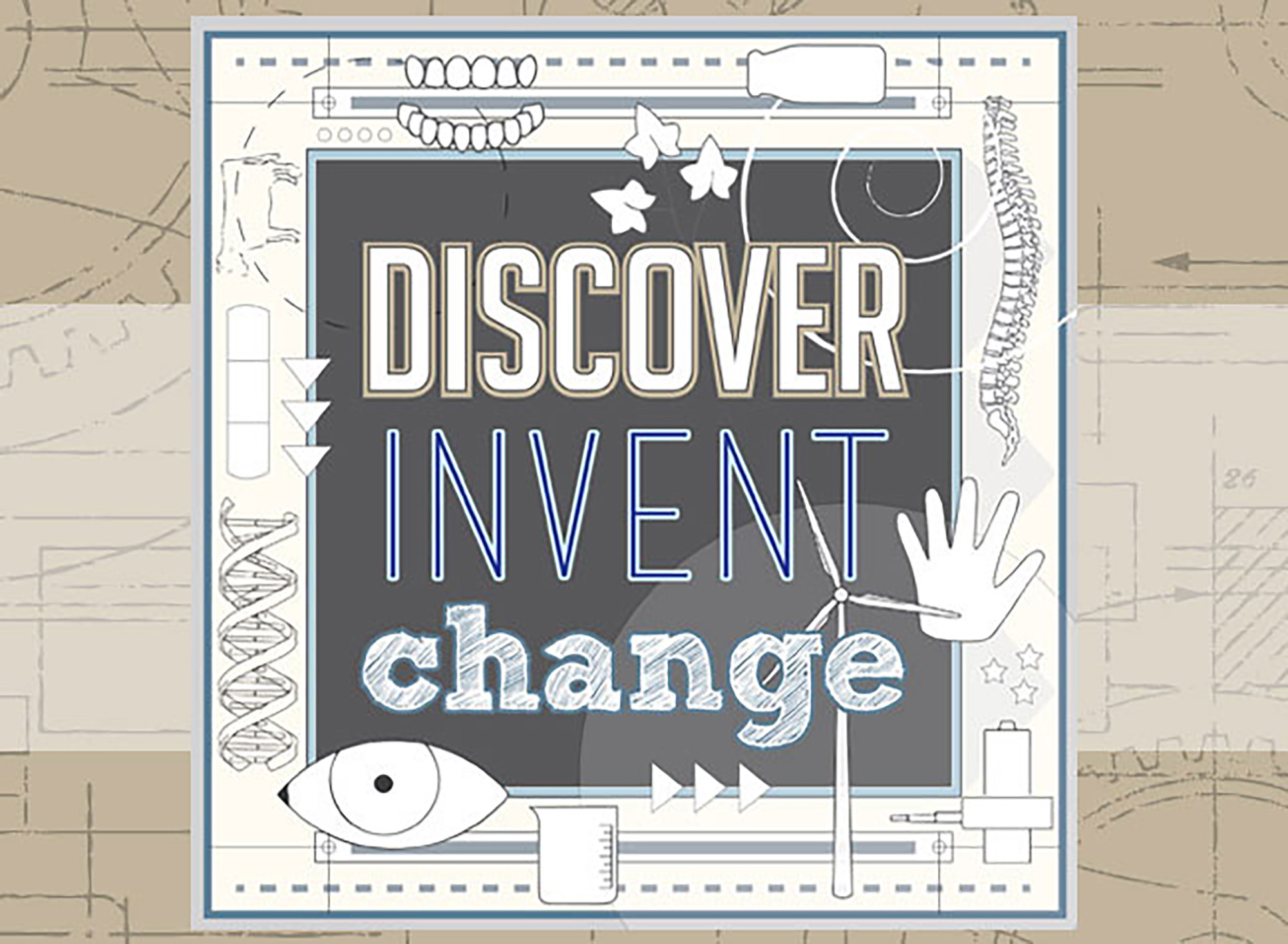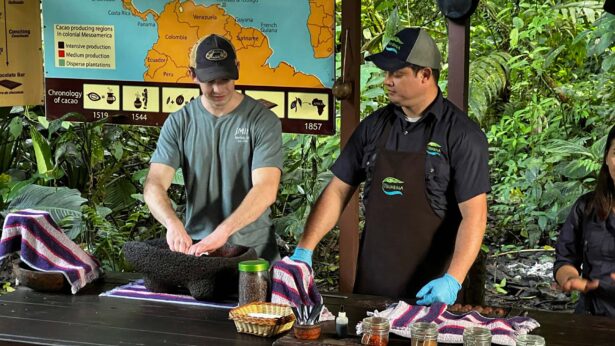Photography and Story by David Brill
For these UT scientists, the process of discovery began with an idea and ended with a patent for a device, concept or material entirely new to the world.
In literature and film, the archetypal professor stands at the head of the class, addressing a room full of eager students scribbling notes. But that portrayal omits what remains an essential role for most of UT’s contemporary scholar-scientists, many of whom divide their time between the lectern and the laboratory.
There’s no doubt that the process of discovery that unfolds in the laboratory enlivens the classroom environment, but it also has spurred creation of a range of devices, concepts and materials new to the world. These 12 UT-based inventions are influencing—and in some cases transforming—fields as wide ranging as nanotechnology and material science, medicine and forensics, livestock fertility and national security, dentistry and energy storage. And the UT Research Foundation, which helps commercialize intellectual property, has been an engaged and enabling partner for nearly all of them.
In the following story, Tennessee Alumnus presents 12 inventions—representing UT Knoxville, UT Chattanooga and the UT Health Science Center in Memphis. In all cases, the process of creation began with a pestering problem and ended with a “Eureka” moment that yielded the solution.
1. The Spine Robot
Platform replicates human spine to test surgical implants

The human spine is an engineering marvel capable of bearing the combined load of the muscles, organs and bones of the upper body yet flexible enough to allow us to drive a golf ball or bend to pick a flower. But the spine also is vulnerable to injury and the ravages of age, and as life expectancy grows, the spine increasingly becomes a target for surgical intervention. In fact, spinal implants—among them, disc replacements, immobilizing rods, and metal plates and screws—will soon burgeon into a $10 billion industry, and Memphis is an international hub of medical device manufacturing. To bolster the industry’s success—and precision—Denis DiAngelo and Brian Kelly, UTHSC professors of biomedical engineering, have designed and built the Spine Robot, a test platform that replicates the spine’s natural range of motion. Segments of cadaver spines featuring surgical implants serve as test subjects. Data produced by the Spine Robot allow device manufacturers and spine surgeons to assess the performance of these implants—under precisely controlled loads and degrees of motion that simulate actual physiologic conditions—before they’re surgically placed into living patients. Since designing and building the Spine Robot nearly a decade ago, the researchers have tested more than 200 surgical devices. Many of the pre-test implantation procedures take place at the Medical Education and Research Institute, a nonprofit school and lab in Memphis where surgeons employ the same tools and techniques they would use on living patients in a hospital’s operating room. DiAngelo and Kelly see their work as a complement to a spine surgeon’s cumulative clinical experience. After performing an implantation procedure multiple times, surgeons learn which techniques and devices work and which are prone to failure. Implant failure not only leaves the patient with an unresolved back injury; it also exposes him or her to further surgical intervention, with all the attendant risks. DiAngelo and Kelly can provide the up-front science needed to advise surgeons on which interventions are more likely to result in successful outcomes.
For more information, visit the UT Research Foundation website: utrf.technologypublisher.com/technology/12889.
2. Elements of Invention
3D spiral better displays the periodic table

The atoms that form the elements—even modest hydrogen, with its single orbiting electron—are made up of lively particles that inhabit a three-dimensional plane. Yet, for more than a century, chemistry education around the world has limited the arrangement of the elements to two dimensions and confined them in rectangular boxes on the orderly but utterly uninspiring periodic table. Hinsdale Bernard, a professor in UTC’s School of Education, believes the elements deserve a more vibrant presentation and has arrayed the elements’ seven periods, 18 groups and four blocks in multiple layers and colors on the three-dimensional—and patented—Bernard Periodic Spiral of the Elements. In size and shape, the product, developed by Bernard and his startup company 3DPT Enterprises, LLC, resembles a table-top Christmas tree. Bernard’s first prototype traces to 1977 in Trinidad and Tobago, where he worked as a high school chemistry teacher. Challenged to come up with an entry for a national science exhibition, Bernard and his students configured the elements into a spiral with Styrofoam balls, sized to reflect the elements’ atomic radii, arrayed around a central post. A photo of the resulting structure made its way onto the cover of the February 1978 edition of the Journal of Education in Science for Trinidad and Tobago. Now, 36 years and four prototypes later, the product, which is easily assembled and collapsed, is market ready and, priced at about $200, would provide an affordable, decorative and educational fixture for elementary- and middle-school classrooms. The individual “elements” (picture large guitar picks with tabs) are removable and fit into their numbered slots. The product comes with a user guide that targets early learners, and Bernard currently is pilot testing an interactive game, Groupperoid, to help beginners learn the chemistry alphabet.
For more information, visit the 3DPT Enterprises, LLC, website: 3dptenterprises.com.
3. Hand in Glove
HandMinder helps stroke victims recover movement
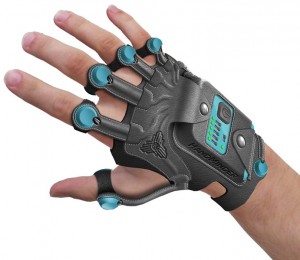 Each year, nearly 800,000 Americans suffer strokes, and more than half of those who survive are left with varying degrees of hand dysfunction—often in the dominant hand. This limits their ability to eat, dress “or to hug their loved ones,” says Randall Nelson, UTHSC neurobiologist and associate vice chancellor for research. “That reality makes hand dysfunction both isolating and debilitating.” In the not-too-distant future, surviving stroke victims may re-establish the neural pathways linking the damaged brain to the hand simply by donning a glove. Through varying patterns of vibration, the HandMinder glove signals the patient to move specific fingers, and in the process, the brain becomes an active participant in the rehabilitation process. Most current therapies for stroke victims are passive, involving cumbersome machines that flex the muscles of the hand but, notably, may not fully strengthen the hand-brain link.
Each year, nearly 800,000 Americans suffer strokes, and more than half of those who survive are left with varying degrees of hand dysfunction—often in the dominant hand. This limits their ability to eat, dress “or to hug their loved ones,” says Randall Nelson, UTHSC neurobiologist and associate vice chancellor for research. “That reality makes hand dysfunction both isolating and debilitating.” In the not-too-distant future, surviving stroke victims may re-establish the neural pathways linking the damaged brain to the hand simply by donning a glove. Through varying patterns of vibration, the HandMinder glove signals the patient to move specific fingers, and in the process, the brain becomes an active participant in the rehabilitation process. Most current therapies for stroke victims are passive, involving cumbersome machines that flex the muscles of the hand but, notably, may not fully strengthen the hand-brain link.
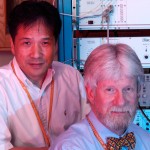
HandMinder inventor UTHSC neuroscientist Yu Liu crafted the first prototype from a Walmart glove, a microchip and a collection of vibrating actuators from a cell phone. Now in its third prototype, the HandMinder features 12 actuators on the fronts and backs of the five fingers and the wrist. At $1,500 or less, HandMinder will be inexpensive—particularly compared with other in-home therapy devices that can cost $10,000 or more—and patients can use the device any time, any place. And Nelson insists that the glove’s sleek, futuristic design will encourage compliance. “Patients aren’t going to use a device that scares the grandkids,” he says. In 2012, Liu, Nelson and associates formed a startup company with $50,000 in seed funding from the Memphis-based medical device incubator ZeroTo510. They plan to conduct a small-scale clinical trial soon to test the device’s efficacy, as a preliminary step in gaining FDA approval.
For more information, visit the HandMinder website: handminder.com.
4. Milk Money
Embryo Guard promotes fertility in cows

For a beef or dairy farmer, a pregnant cow is money in the bank (and, for us, the steak on our plate or the milk on our morning cereal), provided the cow carries the calf to term. Upwards of 70 percent of embryonic losses in cattle occur during the first two weeks after fertilization when a range of stressors—including heat, disease, ingestion of toxic plants or the uterine manipulation necessary for harvesting or implanting embryos—triggers the release of the destructive hormone prostaglandin F2a (PGF2a). The embryo’s cells feature receptors for PGF2a, which, once attached, retards the embryo’s development. Two researchers from UT’s Institute of Agriculture have devised a technique for protecting the embryo during the critical first few days following fertilization. In the uterus, Embryo Guard blocks the effects of PGF2a by preemptively binding with the embryo cells’ receptors. “It’s essentially like protective bubble-wrap for a developing embryo,” says F. Neal Schrick, professor and head of the Department of Animal Science in the Institute of Agriculture. Schrick developed Embryo Guard with colleague J. Lannett Edwards, animal science professor and graduate program director. Embryo transfer—a multimillion-dollar industry—involves harvesting embryos from genetically superior donor cows that have been prompted to “super-ovulate” and produce 10 or more eggs. The eggs are fertilized through artificial insemination. Embryo Guard, added to the solution used to flush the embryos from the donor’s uterus, confers protection as the embryos are harvested and before they are transplanted into the surrogate cows that will carry them to term. Schrick and Edwards hold an international patent for Embryo Guard. In 2013, they formed the startup company Fertility Focus Inc. with guidance from the UT Research Foundation and in partnership with the regional venture capital organization Tech 20/20.
For more information, visit the Institute of Agriculture’s Reproductive Research Program website: animalscience.ag.utk.edu/Research-Reproduction.html.
5. Smart Bandage
Computer chip treats wounds, signals for help
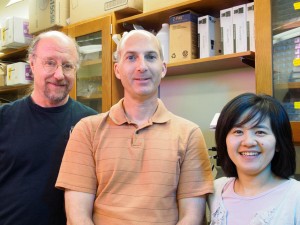
For the cook who cuts a finger with a knife, first-aid products are nearby, in the home’s medicine cabinet. But a wounded front-line soldier, miles—and hours—from the nearest aid station, faces the risk that the wound will become infected. Steven Ripp, James Fleming and Tingting Xu, researchers at the UT Knoxville Center for Environmental Biotechnology (CEB), want to equip soldiers—and others who might sustain wounds far from help—with a bandage smart enough to treat infection and also signal for help. At the heart of the device lies the bioluminescent bioreporter integrated circuit (BBIC), a computer chip about half the size of the nail on your pinky. The chip works in tandem with bacteriophages, naturally occurring viruses that feed on bacteria, and a separate (noninfectious) bacterium genetically engineered to emit light. As the bacteriophages enter the cells of Streptococcus pyogenes (strep), Staphylococcus aureus (staph) or other pathogen that commonly infects wounds, the invaded bacteria release a chemical that, in turn, signals the bioluminescent bacteria to begin to glow. The emitted light serves two functions. First, it signals the BBIC of the presence of infection, and the BBIC responds by emitting electrical pulses that cause benign bacteria woven into the bandage’s fabric to synthesize and release a cascade of pathogen-killing enzymes. Second, the BBIC transmits a signal via radio frequency to a hand-held sensor carried by medical personnel, alerting them to the presence of an infection and identifying the specific pathogen. Because the smart bandage uses enzyme-based antimicrobials—rather than traditional antibiotics like penicillin—there is less risk that the pathogens will develop resistance to the drug. The CEB researchers have tested all of the bandage’s components and expect to have a functioning bandage within two years. UT’s Textiles and Nonwovens Development Center will manufacture the fabric containing the bandage’s active microbes and computer chip.
For more information visit the CEB website: ceb.utk.edu.
6. Guess Who?
Computer-based tool speeds DNA match and identification
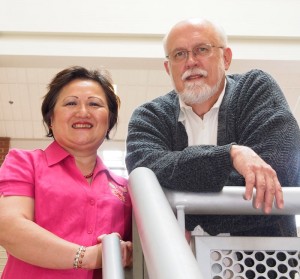
DNA recovered from crime scenes or taken from recovered human remains provides a powerful tool for identifying perpetrators or victims by searching for matches through databases of DNA profiles. Until recently, the process was slow because it required a one-by-one comparison of the DNA from a crime scene or recovered body to each DNA profile in a database that might contain millions of profiles. UT Knoxville’s J. Douglas Birdwell, professor of electrical engineering and computer science, and Tsewei Wang, associate professor emerita of chemical and biomolecular engineering, have patented a computer-based tool that achieves a 1,000-fold increase in the speed of the identification process. Wang explains the technique by referencing the game Guess Who?, in which one player identifies a mystery person on a card held by an opponent based on a series of yes-or-no questions pertaining to physical attributes: Does your person wear glasses? A hat? Have blond hair? In the context of the game, the old DNA search method confirmed identity only after receiving yes-or-no responses for the entire list of distinguishing physical characteristics. Birdwell and Wang’s technique is based on asking the correct yes-no questions at the outset of the search, based on the presence or absence of combinations of specific DNA alleles. Alleles are genetic markers we inherit from our parents and that occur at known locations on chromosomes. Because certain allele genotypes are more common than others in the general population, Birdwell and Wang’s “indexing” technique divides the entire DNA database into groups. By asking the correct questions about the genotype they seek to match, many groups of DNA profiles can be eliminated from the search. Once Birdwell and Wang’s tool has dramatically reduced the pool of possible matches, a linear (one-by-one) computer search can help identify a recovered body or perpetrator of a crime. Birdwell and Wang hold 19 patents related to the forensic use of DNA for human identification, including techniques for identifying remains based on genetic profiles provided by family members. These methods can help confirm the fate of missing loved ones in the aftermath of genocide, natural disasters, airline crashes and other mass-fatality events, like the terrorist attacks of 9/11.
7. Value of Ivy
Sticky plant nanoparticles could protect skin

UT Knoxville biomedical engineer Mingjun Zhang sees beauty in the myriad plant species that sprawl around him, but he also looks to them for inspiration. Take English ivy (Hedera helix), for instance. In 1875, scientist Charles Darwin first described the plant’s yellow exudate that allows it to cling tenaciously to vertical surfaces. Now, 138 years later, Zhang, with the help of an atomic-force microscope and other nano-scale instruments, has unlocked the secret to ivy’s unique adherent properties, which could aid in the development of a range of commercial products. The ivy’s rootlets exude tiny uniform particles measuring about 70 nanometers across (about half the size of a typical bacterium) in a liquid polymer matrix. The liquid’s small particles allow it to penetrate minute cracks, holes and other surface features, and it cross-links as it dries to form a durable, waterproof bond that retains its adherent properties long after the plant dies. Zhang insists that commercial adhesives based on this natural glue could be “tuned”—or adjusted—through chemical processes to enhance strength and adhesion, for permanent bonds or to achieve less-permanent adhesion for shorter-term applications (for instance, attaching a temporary crown to a tooth). But ivy’s nanoparticles also boast other useful properties. Using a spectrophotometer, Zhang and colleagues determined the nanoparticles’ ability to absorb and deflect UV-A and UV-B solar rays, which damage skin and can cause cancer. Many existing sunscreens employ metal-based nanoparticles—including zinc and titanium oxides—to shield the skin, but there’s the risk that these particles may cause health concerns after entering the body. Not only are ivy’s nanoparticles significantly more effective than metal oxides at protecting the skin from UV radiation, but they’re nature based and biodegradable, and Zhang’s tests have confirmed that the particles pose no health risks. If we understand what makes ivy stick, Zhang insists, we might also develop surface coatings to keep it from sticking. Ivy could damage buildings, and barnacles, which use a similar mechanism to bond to—or foul—the hulls of ships, dramatically increase fuel costs. A surface application of an anti-adhesive could keep campus halls and ship hulls free from two of nature’s premier hangers-on.
8. Radiation Rescue
RX100 could save victims of radiation exposure
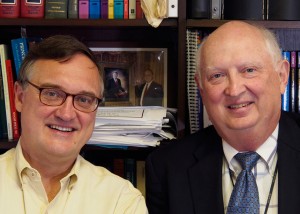
Exposure to lethal doses of radiation killed nearly 30 firefighters and plant workers in the 1986 Chernobyl nuclear disaster. A new drug currently being tested at UTHSC might have saved many of them, even if administered hours after exposure. The Fukushima Daiichi nuclear accident of 2011 provides a more contemporary lesson on the dangers of radiation, according to Gabor Tigyi, professor and head of the UTHSC Department of Physiology. “With Fukushima, humankind got a sobering reminder that we’re playing with fire, and we don’t yet have a fire extinguisher,” he says. But, thanks to Tigyi and colleague Duane Miller, UTHSC Van Vleet endowed professor and head of the UTHSC Department of Pharmaceutical Sciences, we may be very close. Tigyi and Miller’s therapeutic “fire extinguisher” is a small lipid-mediating molecule—a biological messenger that prompts a protective cellular response. Tigyi and Miller are developing and testing their molecule under the trade name RX100. Lethal doses of radiation trigger apoptosis, or programmed cell death, where the radiation signals the body’s cells to die. RX100 binds with cells’ protein receptors and, instead, signals the cells to live and repair their damaged DNA. At therapeutic doses, the drug causes no negative side effects. The gastrointestinal tract and bone marrow are particularly vulnerable to the ravages of radiation, and RX100 has proven effective in arresting and reversing radiation-induced cell death in both systems. And trials on nonhuman subjects have proven the drug’s ability both to prevent acute radiation sickness, if taken in advance of exposure, and to mitigate the illness if taken up to 72 hours after exposure. RX100’s unique bioactivity may make it suitable for treating victims of diarrheal diseases, including cholera, which, like radiation, disrupts the cells lining the small intestine. In cancer patients, the drug might help sustain noncancerous cells damaged by the side effects of chemotherapy or radiation treatments. In 2003, Tigyi, Miller and UTHSC colleagues Leonard Johnson and Shannon McCool formed the biotech startup company RxBio Inc. to guide RX100and related products to market.
For more information, visit the RxBio website: rxbio.com.
9. Power Storage
Innovations improve wind and solar energy battery
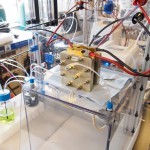
When the sun shines and the wind blows, solar panels and wind turbines feed millions of kilowatts hours of electricity into the nation’s power grid. But, when the sun sets and winds calm, power flowing from these renewable energy sources abruptly ceases. To date, there is no widely available and cost-effective way to store excess solar and wind energy for use during times of peak demand or to rescue end users from power outages. But two UT Knoxville researchers may be on the verge of resolving the energy-storage dilemma. The vanadium flow battery (VFB) has been around since the 1980s, but Thomas Zawodzinski, UT-ORNL Governor’s Chair in electrical energy storage, and Matthew Mench, Condra Chair of Excellence in Mechanical Engineering, have developed techniques for achieving a 2,000 percent increase in the speed at which the VFB’s stored energy can be accessed. The element vanadium can exist in multiple states of electrical charge, making it an ideal energy transport and storage medium.
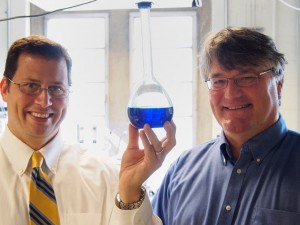
In the VFB, two tanks store electrolyte solutions, one containing positively charged vanadium ions and the other filled with negatively charged vanadium ions. The two solutions are pumped into the battery’s reactor, where they remain separated by a thin membrane. When wind or solar power charges the battery, the vanadium ions in the positive side of the system give up electrons, which travel through the system’s electrodes and are captured by vanadium ions on the negative side. When the battery’s stored energy is discharged and fed into the electric grid, the flow of electrons is reversed. The VFB system can be charged and discharged much like a rechargeable battery, and because both sides of the reactor contain the same element, there is little concern over cross contamination if vanadium atoms penetrate the reactor’s central membrane. VFBs can be configured into large stacks containing multiple reactors, boosting power storage and generation capacity. Zawodzinski and Mench, who gained valuable experience from years spent working on hydrogen fuel cells for the auto industry, are currently seeking patents for their proprietary innovations to improve VFB’s performance and efficiency. These innovations focus on reducing the system’s losses, identifying improved materials for the system’s charge-carrying electrodes and membrane separator, and modifying the reactor architecture. Commercial partners have already stepped forward to license Zawodzinski and Mench’s technologies.
10. Vision Quest
Compound delivers sight-saving drug
A powerful therapy borne by a tiny particle may hold the cure for a progressive eye disease that slowly robs nearly 20 percent of older adults of their vision. Age-related atrophic macular degeneration (AMD) causes the light-sensing cells—the rods and cones—in the macula, an organ in the center of the retina, to die. AMD sufferers retain peripheral vision, but their central vision declines, making it difficult to read, watch TV or perform basic tasks. “The longer you live, the more likely you are to develop AMD,” says Monica Jablonski, UTHSC professor of ophthalmology. “And currently there is no FDA-approved treatment for the disease.”

In a healthy eye, the retinal pigment epithelium (RPE) layer lies just below the rods and cones and nourishes their function. As the RPE layer atrophies, the rods and cones begin to die, and vision ebbs. Jablonski has patented a sugar-based compound, NA3, that binds to receptors in the retina and supplants the role of the damaged RPE in restoring function to the rods and cones. In finding a suitable delivery system for the drug, Jablonski and associates Shankar Swaminathan and Mallika Palamoor thought small—very small. The particles that carry the drug measure less than 300 nanometers across (picture the diameter of human hair—then divide by 200). After injection into the eye, the nanoparticles’ outer polymer layer slowly degrades, resulting in a sustained and steady release of NA3, requiring only one injection per year. Tests on nonhuman subjects indicate the efficacy of the drug and the safety of the delivery system. “Inside the eye, the drug remains active,” says Jablonski, “but once it migrates out of the eye, it quickly degrades in the plasma.” Eventually, Jablonski hopes to gain FDA approval to test the drug on humans afflicted with AMD.
For more information, visit the UT Research Foundation website: utrf.technologypublisher.com/technology/12884.
11. Bomb Detection
Device in trunks locates dirty bombs
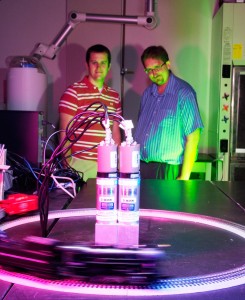
In the post-9/11 world, the truck barreling down the interstate or the shipping container hoisted from a cargo vessel may contain a radiological dispersion device, or dirty bomb. Unlike nuclear detonations that can level a city, the dirty bomb is more disruptive than deadly and relies on conventional explosives to disperse radiation. The materials for dirty bombs are more widely available than those required for nuclear weapons. UT Knoxville’s Howard Hall and his team have developed a mobile, low-cost device to locate dirty bombs and other radiological threats and thwart potential terrorists before they act. “One of our main security challenges is getting a device into the right places at the right times to provide actionable information,” says Hall, UT-ORNL Governor’s Chair in nuclear engineering and Baker Center fellow in global security policy. “If it’s too expensive or complicated, it won’t be deployed.” Hall’s device, which fits in the trunk of a police car, features four bundled radiation detectors. Each includes a sensor that generates pulses of light when a radioactive isotope strikes it. A photomultiplier turns the light into an electrical voltage, which indicates the specific isotope, whether Cobalt-60 or Cesium-137. But the device also signals direction. Picture four people standing back-to-back in the middle of a room. If you shined a light at one part of the human square, the two people closest to the light would receive the most illumination. Likewise, with Hall’s device, software processes the relative intensity of the radiation striking the four sensors and indicates the direction of the source. Hall and associates Steve Skutnik and Michael Willis have demonstrated the approach using a toy train containing a small (benign) radioactive source in one of its cars. Hall will soon test the device in real traffic situations. At under $40,000 per unit and built from off-the-shelf components, the device is cheap enough to become standard equipment for police departments and security agencies across the nation, creating a vast, interlocking surveillance network.
For more information, visit Hall’s research group homepage: howardhall.name.
12. Eroding Values
Mouth rinse protects, rebuilds enamel

Mojdeh Dehghan and Daranee Versluis, faculty researchers at the UTHSC College of Dentistry (CoD), will acknowledge that tooth enamel is the hardest substance in the human body. But they’ll also insist that it’s no match for the stomach’s powerful hydrochloric acid that lurks inches away, just beyond the esophageal sphincter. For most of us, the two substances remain safely separated. But, for people who suffer from acid reflux or bulimia, stomach acid enters the mouth and gradually erodes the enamel covering the teeth. Excessive consumption of acidic sodas and sports drinks also may lead to loss of enamel. If left unchecked, the acid erosion can completely strip the enamel from the tooth, exposing the relatively soft underlying dentin and destroying the tooth’s function. In response, Dehghan and Versluis have devised a two-step mouth rinse that first applies a neutralizing agent to reduce the effect of acids in the mouth and then introduces a remineralizing rinse to rebuild tooth enamel. Research supported by the UT CoD Alumni Association has demonstrated that the proprietary rinse actually enhances the protective effect of saliva, making the combined two-solution process more effective than use of either individually. The UT Research Foundation is helping to obtain a patent for the product and is seeking industry funding for a small clinical trial. Patients with early stages of tooth erosion could benefit from this rinse by minimizing the rate and extent of tooth destruction. Dentists may overlook acid erosion; even a close visual inspection might miss the minute changes occurring in the early stages of the condition. While early detection is possible with a sophisticated computer-based measuring instrument, the proprietary rinse could reach large segments of the population and prevent erosion before it begins. In deference to the 10,000 taste buds that also occupy the mouth, Dehghan describes the product’s flavor as “entirely pleasant.”
